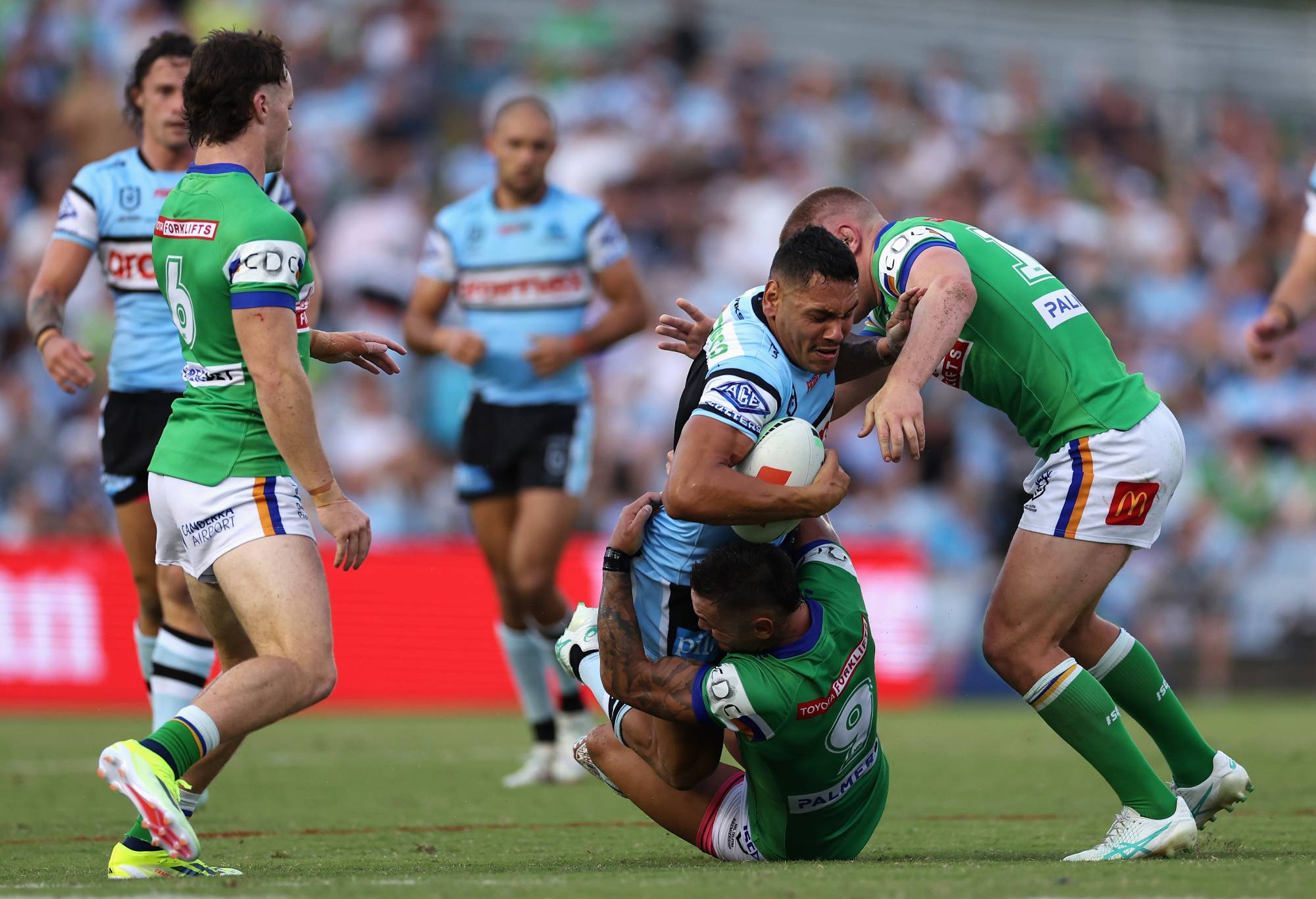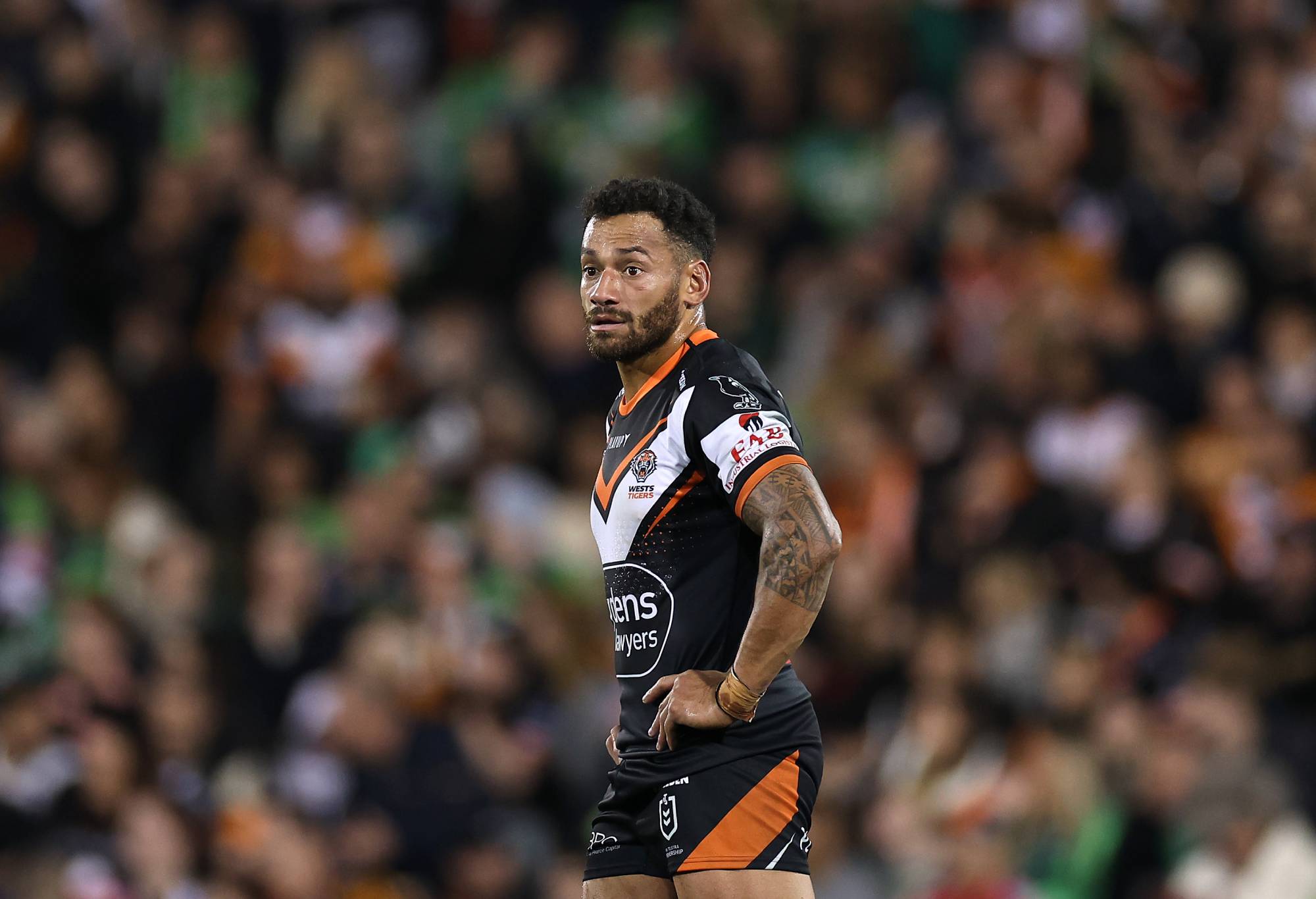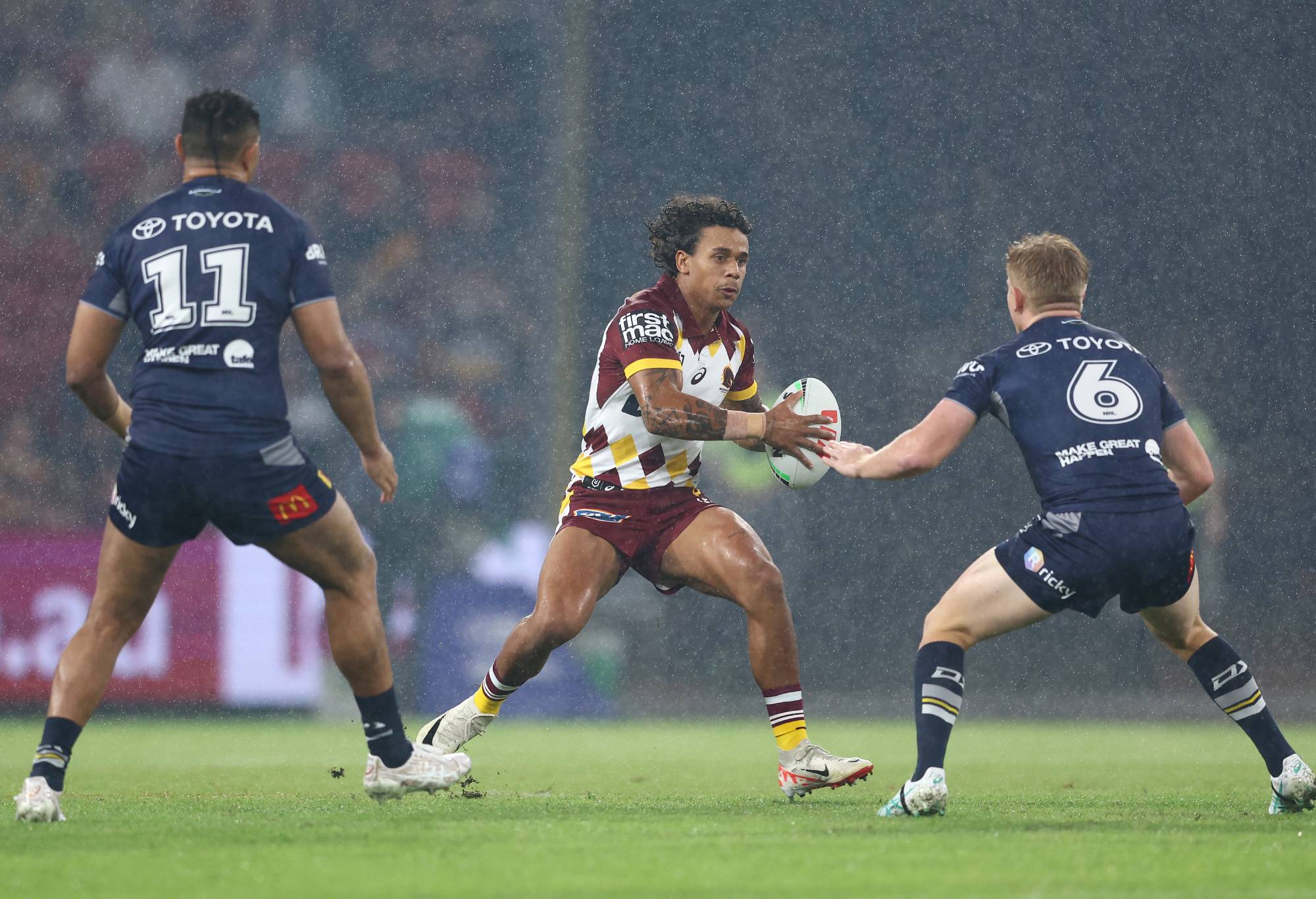If you were paying attention in the first few weeks of the NRL season, you might have noticed two trends, one very overt and one a little more subtle.
One would have had to have been deliberately ignored the rugby league world to miss major debate about obstruction, with several tries wiped and others not, with much fervour on the whys and wherefores of the rules.
The other required a little closer attention, but has been there for all to see, with far more teams trying to play wide than did previously.
It isn’t accidental at all, because the two things are linked.
Firstly, the increase in obstruction, or at least, the increase in interest about the obstruction rules, is a result of more teams playing more complex shapes, which is itself a result in better coaching, more attention to data and some select rule changes that have incentivised more proactive use of possession.
Working from the back to the front, the rules now further incentivise the ‘use-it-or-lose-it’ aspect of rugby league, because the benefit of conservatively moving up the field and then applying pressure through repeat sets is no longer there with short dropouts now encouraged.
Only around a third of short dropouts are retained by the kicker, but that’s a lot more than the near-zero percentage you got with long dropouts, plus plenty of sides like to defend their line from play 1 rather than the arguably more dangerous 20-50m distance that comes from a distance kick.
Then there’s the data, which is clearly having an impact.
Every single NRL team has a lower Pass per Run ratio (PPR) this year, but the number of shift plays has gone up, and the imbalance between those shifts almost ironed out entirely, with a long-standing league-wide preference for the left edge reduced almost 50/50.
The league-average completion rate (CR%) is up a whole 2%, from 76% to 78%, which is the opposite of what you might expect in the early rounds of the year when theoretically the most errors would be made as teams build combinations.
Teams are less interested in the middle of the pitch and more interested in going wide – friend of the column Rugby League Eye Test has done the heavy lifting on this – but doing that without decoys and supports just means going side to side, which you’ll know already if you’ve seen the Dragons play for the last few years.
We’re seeing teams play wider, but also more up-and-down, more expansively but also with fewer errors. What on Earth is going on?
Stats without tactics are nothing, of course, and that’s where the coaches come in.
We’ve seen the most effective coaches in recent years – at least the ones who aren’t called Ivan Cleary, whose Panthers remain their own unique think – do well because they prioritise co-ordinated chaos.
They’ll play quite conservatively in their own end – hence the decrease in PPR and rise in CR%, because the bulk of that is just hit-ups in yardage – but are much more willing to go wide early if the defensive line is condensed.
The Roosters, Cronulla and Souths (when they were good) were big on this in 2022, then were joined by the Broncos, Newcastle and Manly in 2023 and now Canberra, the Cowboys and the Wests Tigers in 2024.
That means more than half the league are now deep attackers, and while not everyone is that good yet, far more teams are open to trying it, even those steeped in conservatism.
If you’re the Bulldogs, for example, it’s not worth having a Rolls Royce edge of Josh Addo-Carr, Stephen Crichton and Viliame Kikau if you don’t get them decent early ball, especially when their red zone attack remains ropey.

Jesse Ramien is tackled. (Photo by Cameron Spencer/Getty Images)
Data increasingly showing that the most valuable space to attack is the centre channel, one in from the wing, so it makes a lot of sense to focus your attack there whenever possible, and the rules now mean that you’re as well going from deep as waiting until the red zone, especially on plays 3 and 4.
It’s why you see more hit-ups, yes, but also more shifts.
So where does the obstruction rule come into this?
Well, if you’re going play straight sometimes and wide at other times then it helps to not have your opponents know which you’re going to do.
Attack in rugby league is all about deception, moving the defensive line to where you want it in an attempt to get the space where you want it to be too.
The Roar League Podcast is on YouTube! Click here and subscribe to make sure you never miss an episode
There’s 13 attackers and 13 defenders, most of whom are good enough at tackling that running over the top of someone is rarely an option, and a pitch of sufficient size (outside of Las Vegas) that takes simply going around the defence out of the equation.
The nub of it is generating quantitative or qualitative advantage, which is tactics talk for moving the defence about to create space, then moving the ball into that space (quantitative) or moving the opposition about to get a favourable match-up (qualitative).
You get more numbers than them and it’s three-on-two, which anyone who has played touch footy will understand.
You get your big/fast/evasive player against their small/slow/static player and you’re suddenly through, or at least generating the offload that gets you through.
How you create those advantages is deception.

(Photo by Cameron Spencer/Getty Images)
Api Koroisau wiggles his backside to move the markers one way, then goes the other. Nathan Cleary hides the ball, draws them in, then passes. They’re the individual examples, but most often, it’s men in motion that do it.
It’s why coaches obsess over push support numbers, the indicators of how many bodies are in motion around the footy, either to cause deception, distract attention or to be there to receive offloads.
Even when it doesn’t work, it’s not always a bad sign. Next time you watch a game, count how often a player stops because their teammate has inadvertently obstructed them.
If you want to go deeper, watch who it is who has to give themselves up. It’s rarely the bad players, rather the best.
They don’t do stats on this, but the eye test would suggest that Tom Trbojevic, Jarome Luai and James Tedesco are among the highest, and that’s no accident.
You run the deception shapes specifically because you want to hide that you’re trying to get the ball to one of your big weapons, the guys you want to have the maximum opportunity in attack.
You end up falling to your front to surrender because the timing is off from the other blokes around you, which is the sort of thing that happens when multiple moving parts are at play.
When you get the supports and the ball in sync, however, the magic happens.
If, for example, you can condense the line by drawing multiple bodies to the ruck, it means that they aren’t elsewhere, with the net effect that there are either holes in the line, men isolated with room around them or space around the outside.
It’s not just in attacking structure that these things matter, because they also allow set defences to fully load up on yardage runners if nobody goes with them.
Trent Robinson has emphasised them for years – no wonder that his protégé Craig Fitzgibbon has done the same at the Sharks – and was raging at half-time in the Roosters’ recent defeat to Penrith as his men took the ball too one-out from their own end. They had no supports, so the Panthers defence loaded up.
We’ve seen plenty of example of teams using men in motion around the middle of the field to create space out wide but what is increasingly happening as defences become aware of more expansive gameplay is the ability to do so down the middle.
Think back on that Manly try that wasn’t against Parramatta: Luke Brooks runs across the line and has a supporter, Ethan Bullemor, as a decoy for Tommy Turbo, who eventually gets the ball and runs right through the gap that Luca Moretti should be in.
Now, Moretti gets away with it because Jake Trbojevic is in the line, but we all know that he wouldn’t have got there anyway because he’d stopped. The space was created by movement elsewhere that allowed the Parra forward, and others, to think other things were happening.
Manly have been doing this a lot, with either Jurbo or Nathan Brown ball-playing to move the play away from the ruck, but always with men in motion.
If you watch the freeze frame, it’s easy to see how the move could otherwise have played out with a four-on-three outside of the Eels line or Tolu Koula, a very fast player, up against his opposing centre with space to run into.
Wayde Egan has made an art form of this at the Warriors, as has Koroisau over years, and the Raiders now have added turning players under into space as a key tactic, particularly with Matt Timoko.
The way they moved the Parramatta defence around on Sunday night was a masterclass in it: they hid their best weapon, Timoko, until the last moment, faking that they would either go wide or inside before dropping him under to bust tackles and break through, before later doing the opposite.
It’s deception 101, and happening from further and further out from the goalline.
The way the Raiders set up for Hudson Young’s try had three men run for the ball on the left side of the ruck, taking all Parra’s middle with them, before Danny Levi moves the play right, catching them all slacking in space that Timoko will eventually run through.
Here’s another example, a beauty from the James Maloney-written Cowboys playbook at the weekend, from closer to the line.
North Queensland have three men in motion on the one play, all aimed at the same space on the field, the Titans’ right channel.
Sure, the Titans couldn’t tackle a fish supper at the moment, but still, the way that the gap is prized open is a thing of beauty, with Tom Dearden running one angle to the left, Kulikefu Finefeuiaki to the right and Scott Drinkwater out the back.
Off ball work, as explained in depth by Broncos assistant Lee Briers to this publication last year, are totally free and only require effort areas to enact.
Getting it right isn’t easy, as evidenced by the number of obstruction calls and surrenders we see, but the increasing sophistication of men in motion is changing what rugby league looks like at the elite level, making the once risky into something a lot more reliable.
Previously playing expansive, attack-first footy inherently brought errors with in, making extra defensive efforts an occupational hazard.

Tristan Sailor. (Photo by Chris Hyde/Getty Images)
Now, smart coaches are seeing results from incremental efforts with the ball that allow shorter, more secure passes to hit their target wider out.
Going through the hands with men in motion turns longer, riskier passes into shorter, more manageable ones while still maintaining the interest of the line.
It’s shifting the errors onto support runners, with the punishment now a lost tackle rather than a lost ball.
Not that long ago, the sensible practice in soccer was to get the ball as far from your goal as possible and take risks only in attack, with ‘if in doubt, kick it out’ the mantra and launching the ball forward at the earliest opportunity the order of the day.
With the advent of analytics and better tactical coaching, it was realised that short passes from the goalkeeper forward allied to constant off-ball movement and pressing when the ball was lost resulted in more control, more goals and better results.
The risk was spread across the field, including in your own half, but the risk attached to every pass was lessened. Ten short passes were more likely to find their target than one long one, but only if your players moved enough to create space.
Now, we might be seeing that mentality take over in rugby league. If the first five rounds of the NRL are anything to go by, it should be a lot of fun.































































































